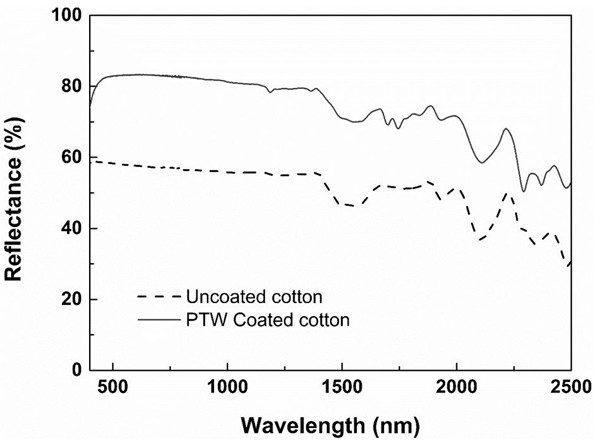Method for constructing fabric surface with passive daytime radiation cooling function and special wettability function
A technology of radiation cooling and functional fabrics, which is applied in the direction of plant fibers, light-resistant fibers, textiles and papermaking, etc., can solve the problems of expensive preparation costs and complicated operation processes, and achieve controllable reaction conditions, simple and easy-to-operate processes, and source of raw materials wide range of effects
- Summary
- Abstract
- Description
- Claims
- Application Information
AI Technical Summary
Problems solved by technology
Method used
Image
Examples
Embodiment 1
[0035] Step 1: Let polydimethylsiloxane form an emulsion in water by means of ultrasound;
[0036] In one embodiment, this step can be specifically performed as follows: at a mass ratio of 1.5 wt%, polydimethylsiloxane is added to deionized water, and ultrasonicated at 40 °C for 3 h to form an emulsion.
[0037] Step 2: The potassium titanate whiskers are uniformly dispersed in the emulsion in the previous step to form a suspension by means of ultrasound.
[0038]In one embodiment, this step can be specifically performed as follows: first, cut 4 pieces of cotton cloth according to the size of 5×5 cm, and put them in a beaker, and then undergo ultrasonication with acetone, deionized water, and absolute ethanol for 10 minutes, and place the Dry in an oven at 60°C and cool for later use. Weigh 0.5 g of potassium titanate whiskers on an electronic balance for later use, place the emulsion obtained in step 1 in an ultrasonic environment, slowly add the weighed potassium titanate w...
Embodiment 2
[0043] Step 1: Let polydimethylsiloxane form an emulsion in water by means of ultrasound;
[0044] In one embodiment, this step can be specifically performed as follows: Add polydimethylsiloxane to deionized water at a mass ratio of 0.5 wt%, and ultrasonicate at 30°C for 10 h to form an emulsion.
[0045] Step 2: The potassium titanate whiskers are uniformly dispersed in the emulsion in the previous step to form a suspension by means of ultrasound.
[0046] In one embodiment, this step can be specifically performed as follows: first, cut 4 pieces of cotton cloth according to the size of 5×5 cm, and put them in a beaker, and then undergo ultrasonication with acetone, deionized water, and absolute ethanol for 10 minutes, and place the Dry in an oven at 60°C and cool for later use. Weigh 0.5 g of potassium titanate whiskers on an electronic balance for later use, place the emulsion obtained in step 1 in an ultrasonic environment, slowly add the weighed potassium titanate whisker...
Embodiment 3
[0048] Step 1: Let polydimethylsiloxane form an emulsion in water by means of ultrasound;
[0049] In one embodiment, this step can be specifically performed as follows: Add polydimethylsiloxane to deionized water at a mass ratio of 2.0 wt%, and ultrasonicate at 50°C for 0.5 h to form an emulsion.
[0050] Step 2: The potassium titanate whiskers are uniformly dispersed in the emulsion in the previous step to form a suspension by means of ultrasound.
[0051] In one embodiment, this step can be specifically performed as follows: First, cut 4 pieces of cotton cloth according to the size of 5×5 cm, and put them in a beaker, and then undergo ultrasonication with acetone, deionized water, and absolute ethanol for 10 minutes, and put Dry in an oven at 60°C and cool for later use. Weigh 0.5 g of potassium titanate whiskers on an electronic balance for later use, place the emulsion obtained in step 1 in an ultrasonic environment, slowly add the weighed potassium titanate whiskers int...
PUM
 Login to View More
Login to View More Abstract
Description
Claims
Application Information
 Login to View More
Login to View More - R&D
- Intellectual Property
- Life Sciences
- Materials
- Tech Scout
- Unparalleled Data Quality
- Higher Quality Content
- 60% Fewer Hallucinations
Browse by: Latest US Patents, China's latest patents, Technical Efficacy Thesaurus, Application Domain, Technology Topic, Popular Technical Reports.
© 2025 PatSnap. All rights reserved.Legal|Privacy policy|Modern Slavery Act Transparency Statement|Sitemap|About US| Contact US: help@patsnap.com



